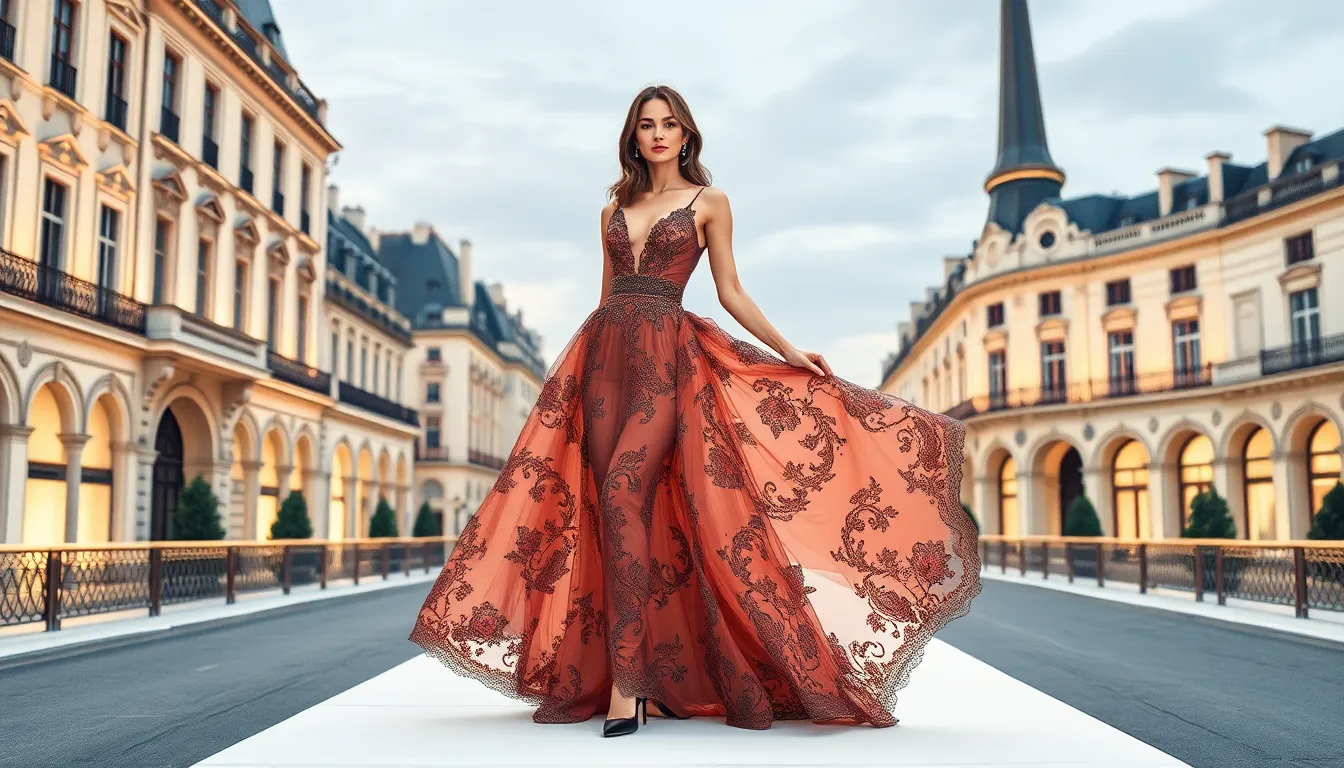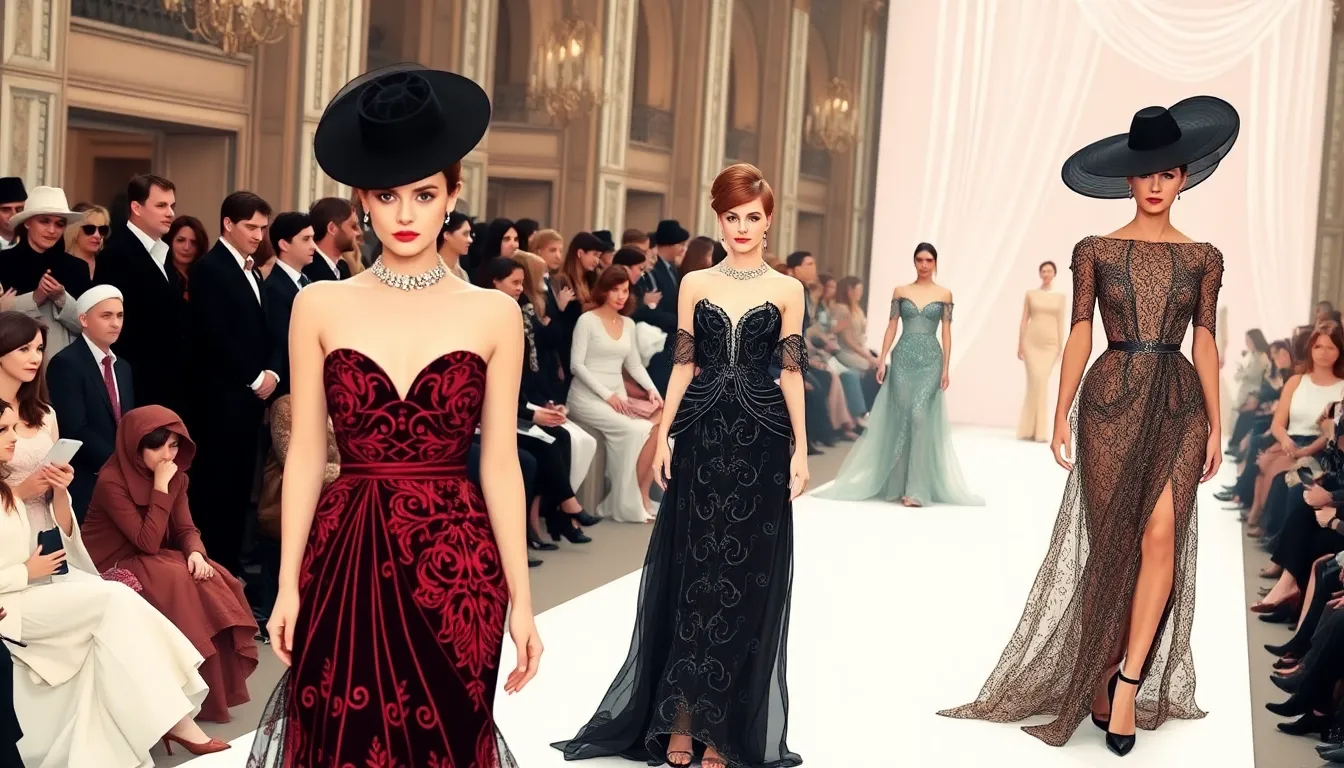Physical Address
304 North Cardinal St.
Dorchester Center, MA 02124
Physical Address
304 North Cardinal St.
Dorchester Center, MA 02124

Haute couture isn’t just a fancy French term that sounds like a delicious pastry. It’s the pinnacle of fashion, where creativity meets craftsmanship in a dazzling display of artistry. Imagine garments that are custom-made, tailored to perfection, and often more intricate than a Rubik’s cube on a caffeine high. For fashion enthusiasts, understanding haute couture is like unlocking a secret door to a world where fabric becomes a canvas for dreams.
But what does haute couture really mean? It’s more than just a label; it’s a commitment to quality, exclusivity, and a sprinkle of fabulousness. From the runways of Paris to the wardrobes of the elite, haute couture represents the ultimate in luxury fashion. Dive into the enchanting realm of haute couture and discover why it’s the gold standard for style aficionados everywhere.
Haute couture refers to high fashion that embodies exclusivity and superior craftsmanship. The term originates from French, meaning “high sewing.” Each piece undergoes meticulous design and construction, tailored specifically for an individual client. Notably, haute couture garments often feature elaborate details and luxurious fabrics, setting them apart from ready-to-wear collections.
Fashion houses must adhere to specific criteria to be recognized as haute couture. Specifically, they must create custom-fitted clothing for private clients, maintain a workshop in Paris, and present a collection of at least 50 unique designs annually. Strict regulations govern the practice, underscoring the dedication to artistry and precision in each piece.
Only a select number of fashion houses, such as Chanel, Dior, and Givenchy, qualify as members of the Chambre Syndicale de la Haute Couture. These institutions establish the standard for haute couture, showcasing collections during Paris Fashion Week each January and July. Their presentations captivate audiences with the extraordinary quality and innovative designs that define this elite category of fashion.
Craftsmanship plays a pivotal role in haute couture, where skilled artisans utilize traditional techniques to execute intricate garment details. Fine embroidery, hand-sewn embellishments, and unique textile treatments exemplify the level of artistry involved. Such dedication transforms each piece into a wearable masterpiece, reflecting the designer’s vision and the wearer’s identity.
Overall, haute couture embodies the essence of luxury, serving as a benchmark for fashion excellence globally.

Haute couture has a rich and complex history rooted in fashion evolution. It reflects the ongoing journey of creativity, craftsmanship, and exclusivity.
The origins date back to the mid-19th century in Paris. English designer Charles Frederick Worth is widely credited as the pioneer of haute couture. He established his fashion house in 1858, offering custom designs for affluent clients. Worth’s creations emphasized individuality, utilizing luxurious fabrics and intricate detailing. As a result, the term “haute couture” emerged, signifying high-quality, custom-made clothing. Fashion media began covering his collections, amplifying the concept of personalized fashion. The exclusivity surrounding haute couture attracted the elite, elevating its status in the fashion world.
Over time, haute couture adapted to changing societal norms and artistic movements. The early 20th century marked a period of innovation, with designers like Coco Chanel and Christian Dior redefining women’s fashion. Chanel introduced simpler silhouettes, promoting comfort alongside sophistication. Dior’s “New Look” in 1947 revolutionized women’s wear, emphasizing femininity. Each era saw designers experiment with fabrics and techniques, integrating modern art influences. The late 20th century introduced globalization, enabling diverse cultural expressions within haute couture. Currently, digital technology impacts the industry, allowing for innovative patterns and designs. Despite such changes, haute couture maintains its core values of craftsmanship and exclusivity.
Haute couture embodies the highest standards of fashion. It showcases several key characteristics that distinguish this exclusive realm.
Exclusive designs remain at the forefront of haute couture. Each piece is custom-made, catering to individual tastes and preferences. Designers often push creative boundaries, leading to innovative silhouettes and unique styles. No two garments are alike, as artisans pour time and skill into every creation. Moreover, fashion houses limit their collections, enhancing the sense of rarity and desirability. A well-designed haute couture dress not only reflects the artist’s vision but also enhances the wearer’s identity, making it a true statement piece.
High-quality materials define haute couture garments. Luxurious fabrics like silk, satin, and lace serve as the foundation for each creation. Designers meticulously select materials based on texture and drape, ensuring they complement intricate designs. Exceptional attention to detail leads to the use of hand-embroidered embellishments and delicate finishes. Furthermore, sourcing rare textiles from around the world adds a layer of exclusivity to each piece. Such commitment to quality elevates haute couture above ready-to-wear collections, solidifying its status as the pinnacle of fashion craftsmanship.
Haute couture and ready-to-wear represent different ends of the fashion spectrum, each serving distinct purposes and audiences.
Production processes significantly differentiate haute couture from ready-to-wear. Haute couture garments are custom-made for individual clients, requiring hundreds of hours of meticulous work by skilled artisans. Designers create each piece in-house, ensuring impeccable craftsmanship and unique details. In contrast, ready-to-wear collections focus on mass production. These garments are designed for a broader market, incorporating standardized sizing and faster manufacturing techniques. While ready-to-wear pieces offer accessibility and affordability, haute couture prioritizes exclusivity and artistry, leading to a higher price point.
Target audiences for haute couture and ready-to-wear diverge dramatically. Haute couture caters to high-net-worth individuals seeking exclusivity and personalized service. Clients invest in unique pieces that reflect their identity and status. Designers often develop strong relationships with their haute couture clientele, generating bespoke experiences. Conversely, ready-to-wear appeals to fashion enthusiasts and everyday consumers. This market segment values style and practicality, with a focus on broader fashion trends. Ready-to-wear garments are designed to be more accessible, satisfying diverse tastes and budgets while still offering stylish options for various occasions.
Haute couture remains a vital force in contemporary fashion. Its influence extends beyond mere clothing, shaping cultural and artistic conversations in numerous ways.
Haute couture unleashes creativity within fashion design, serving as a reflection of societal values and artistic movements. High-profile shows and unique designs often challenge norms and inspire discussions about identity, gender, and self-expression. Designers frequently draw from cultural heritage, reinvigorating traditional techniques while integrating modern narratives. Each garment transcends its material form, becoming a commentary on cultural shifts or political issues. Couture often collaborates with artists, promoting a synergy between fashion and fine art. The impact reaches far beyond the runway, rippling through various sectors, including performances, media, and visual arts.
Fashion trends often originate from the haute couture runways. Designers experiment with shapes, colors, and techniques that set the tone for upcoming seasons. Unique silhouettes and inventive materials can inspire ready-to-wear collections, offering glimpses of what may soon flood retail markets. High fashion also influences mainstream trends by making niche styles more accessible. Each collection pushes boundaries, often paving the way for new aesthetics that capture public attention. Seasonal shows frequently attract media coverage, amplifying designers’ creative visions and stimulating demand for innovative styles seen on the runway.
Haute couture stands as a testament to the artistry and dedication behind high fashion. Its emphasis on exclusivity and superior craftsmanship ensures that each piece is not just clothing but a unique expression of creativity. The meticulous attention to detail and the use of luxurious materials elevate haute couture beyond mere garments, transforming them into wearable masterpieces.
In a world where fashion often leans towards mass production, haute couture remains a beacon of individuality and luxury. It continues to inspire designers and fashion lovers alike, driving conversations around identity and artistic expression. As it evolves, haute couture will likely remain a defining element of the fashion landscape, celebrating the beauty of bespoke artistry and timeless elegance.